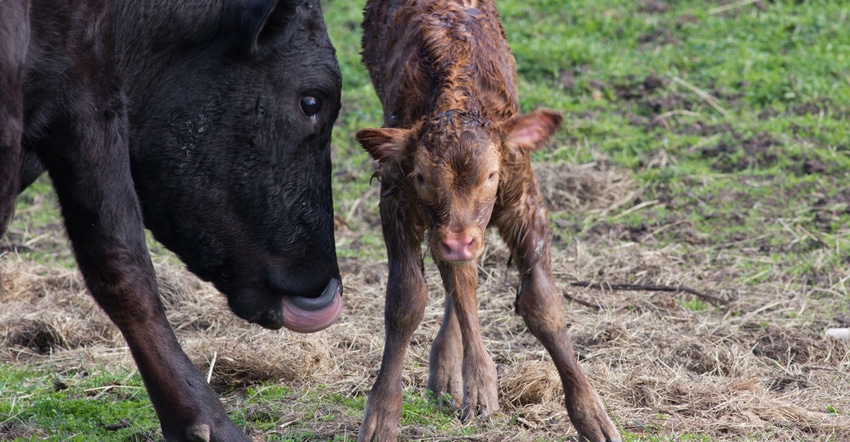February 17, 2022

Editor’s note: This is the first article in a series of two. The second piece, “Measures to take in preparing for weak calves,” will appear next week.
Weak calf syndrome is a term applied to a calf born alive that lacks vigor, is slow to stand and may not attempt to nurse. Affected herds may also see an increase in stillborn calves.
The known factors contributing to the development of weak calves include inadequate nutrition for the dam during pregnancy, difficult calving (known as “dystocia”) and infectious diseases, especially bovine viral diarrhea.
With excellent management, some weak calves will survive, but most will die shortly after birth. Those that survive are prone to develop scours or pneumonia, grow slowly and have lower weaning weights. Although this situation is difficult to correct during calving season, identification and correction of the underlying problems will help prevent this syndrome down the road.
Inadequate prepartum nutrition
Nutrition for the dam is key to preparing a calf for life outside the cow. Not only does the pregnant cow’s diet need to meet her own maintenance needs, but also in the last 50-60 days of gestation, about 80% of fetal growth occurs requiring additional nutrients to support this tremendous growth and to develop the fetal brown fat needed to supply energy to the newborn until adequate colostrum is ingested.
The two most important cow nutritional requirements are protein and energy. The exact amounts of each depend on stage of production, environment and mature cow size. Research has shown calves born to cows on inadequate diets have less vigor, less brown fat stores, less ability to warm themselves, and it takes a much longer time for them to stand after birth.
Heifers and old or thin cows are more likely to have weak calves as they simply cannot compete for hay and feed, and should be fed separately to allow them access to the nutrients they need.
Vitamin and trace mineral deficiencies have also been associated with weak calves. If cows are not supplemented with adequate amounts of selenium during gestation, the calf will be born with a severe selenium deficiency. This deficiency results in “white muscle disease,” a condition where calves are born with a weak heart and skeletal muscles and frequently die soon after birth.
In addition, both vitamins A and E are vital nutrients for cows to pass to the fetus, but may not be adequate in poor-quality forage. Always keep a good trace mineral mix with vitamins in front of the cows, or mix it in supplemental feed to ensure calves are born with sufficient amounts.
Dystocia (difficult birth)
A calf involved in a difficult birth will have decreased vigor and take longer to stand and nurse. A prolonged labor and difficult calving often results in a newborn calf with a swollen head or tongue, bruising, fractures, and excessive fluid in the trachea or lungs.
Low blood oxygen in the calf (hypoxia) from prolonged labor will also impair the function of the central nervous system (brain and spinal cord). Additionally, a calf may have broken ribs that affect its ability to breathe. An easily observed sign of a difficult birth is brown or yellow staining of the calf’s hair coat from the meconium.
If a calf does not stand and nurse within one hour of birth, the calf must be fed colostrum, either milked from the dam or use a commercial colostrum replacement. Colostrum should be given as soon after birth as possible, preferably within one to two hours, and repeated at no later than six hours after birth.
Weak calves born during cold, wet weather with little brown fat can quickly develop hypothermia and are unable to stand or nurse until warmed. A warm-water bath, blow dryer, heat lamp or floorboard heat can quickly warm a cold calf. Beware of heating pads as they can cause burns.
Bovine viral diarrhea and leptospirosis
Both bovine viral diarrhea and leptospirosis have been diagnosed in weak calves. If an unvaccinated or poorly vaccinated cow is infected with BVD during gestation, there are no good outcomes.
The calf may be born weak or born with congenital defects such as a domed head, cleft palate, cataracts and other eye defects, or the calf may be born as a PI (persistently infected) calf.
The other possible infectious cause of weak calf syndrome, leptospirosis, is not fully understood, but studies are ongoing to determine its importance.
Arnold is with the UK Veterinary Diagnostic Laboratory.
Source: OSUE, which is solely responsible for the information provided and is wholly owned by the source. Informa Business Media and all its subsidiaries are not responsible for any of the content contained in this information asset.
You May Also Like




